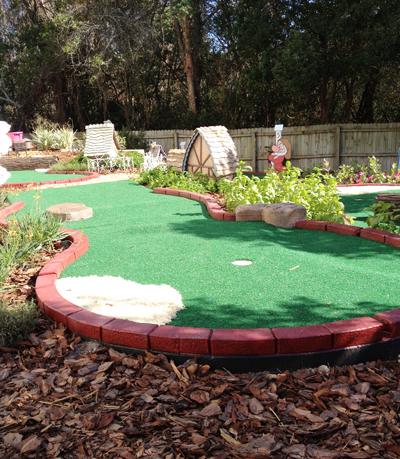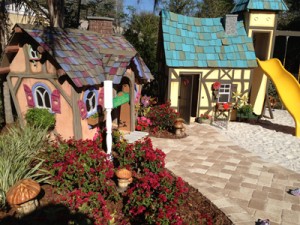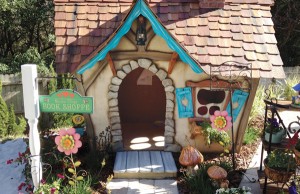From Fairytales to Waterfalls: Unearthing Mother Nature’s Playground
With the school year soon coming to an end, it’s time to spruce up learning opportunities right in your own backyard. Transform an ordinary outdoor space into a captivating, natural wonderland and you’ll harness the curiosity and imagination of your children in a whole new way. With a little ingenuity, you can create a multi-sensory landscape that provides your children with an enriching, fresh-air retreat to enjoy throughout the summer and all year long.
Jocelyn Chilvers, a 30-year veteran in landscape design, as well as an artist, teacher, and author of the blog “The Art Garden,” suggests that homeowners integrate three fun and educational areas into landscape schemes. These zones ─ active play, interactive play, and seasonal observation areas ─ should evolve along with your child’s changing interests.
Active Play Area
 Plan open spaces for active play to accommodate your children’s ages and their favorite activities. While a young child might prefer a sand box and swing set, an older one might need more space for playing croquet or volleyball. Also, add an area in which the children can partake in their activity of choice. “For my three boys, that means unfettered digging! In fact, they have been working on ‘the crater’ for at least three years now,” says Jamie McIntosh, an award-winning writer and author of the blog “Organic Gardens.”
Plan open spaces for active play to accommodate your children’s ages and their favorite activities. While a young child might prefer a sand box and swing set, an older one might need more space for playing croquet or volleyball. Also, add an area in which the children can partake in their activity of choice. “For my three boys, that means unfettered digging! In fact, they have been working on ‘the crater’ for at least three years now,” says Jamie McIntosh, an award-winning writer and author of the blog “Organic Gardens.”
An enclosed area encourages imaginative play. “Kids appreciate an area that feels like they are in their own little world,” Chilvers says, recalling how her daughter played dolls for hours under an apricot tree in their backyard. If you live in an area with few mature trees, create structures for shady retreats, such as a canvas canopy or a gazebo.
Orlando homeowners Geo and Gwen Morales, and their two young daughters, likely to have the ultimate magical space for active play, thanks to their appearance on HGTV’s My Yard Goes Disney. “HGTV and Disney transformed our backyard into an oasis where the girls’ imaginations can run wild! Our very own ‘village square’ allows exploration through a dress shop, book store, castle, mini-golf green, and train,” Geo describes. Regardless of whether you desire an elaborate or a simple themed space, you can get started with the help of a local, experienced landscape designer with formal training in landscape design or architecture. Request examples of family-friendly designs.
Interactive Learning Area
 Designate a space for you and your children to plant a garden or design a birdhouse together. A low bench for potting plants, in addition to a raised garden, makes it fun for a child to participate in the tending process. Reserve a special place for storing gloves and gardening tools.
Designate a space for you and your children to plant a garden or design a birdhouse together. A low bench for potting plants, in addition to a raised garden, makes it fun for a child to participate in the tending process. Reserve a special place for storing gloves and gardening tools.
“Let your child select the plants and actually help plant them,” Chilvers says. “Then, take digital photos and create a picture book.” At the end of the summer, reflect and share in the progression of the garden, reviewing pictures of the work stages ─ planting, watering, and weeding.
Annette Pelliccio, founder and CEO of The Happy Gardener, Inc., whose company provides earth-friendly products to gardeners, says that when her daughters were toddlers she integrated relatable storybook elements into their “play garden.” This included a Charlotte’s Web wire in a tree, a cottage playhouse, and plants with names like Blue Fairy Clematis, Robin Hood tulips, and Ruby Slipper poppies. Now ages 10 and 8, Pelliccio’s daughters recently added a serenity rose garden using several varieties of roses. “They are painting tiles to hang throughout the garden with meaningful words, such as Peace, Family, and Laughter,” Pelliccio says.
Further cultivate an appreciation for the world outside through recycling. “It’s never too early to teach children how to be good environmental stewards,” McIntosh says. “We compost all of our kitchen vegetable scraps and my children like to see what insects are crawling around in the compost bin when we add the scraps!”
Seasonal Observational Learning Area
Children love to study bees collecting pollen, observe birds searching for worms, search for animal tracks, or patiently wait for a butterfly to break out of its cocoon. “Include features in your backyard that allow your child to observe nature and seasonal changes throughout the year,” Chilvers says. Bring in calming water elements and follow the aquatic life cycle of fish and plants. For younger kids, “a self-contained waterfall fountain is safe and inexpensive,” McIntosh says.
Create a bird-feeding station in the winter and identify the visitors. Plant flowers in the spring that will attract bees and butterflies to your garden throughout the summer. In the fall, put the “garden to bed” in preparation for winter, while noting the change of the seasons highlighted in the glory of the evolving colors.
A Multi-Sensory Garden Experience
 Provide children the opportunity to indulge in a garden that satisfies all five of their senses. Plant showy, fast-growing sunflowers or lilies, and fragrant herbs like mint and lemon balm. McIntosh recommends fuzzy, soft lamb’s ears and “the curious sensitive plant, which folds in when touched.” And since children love to pick flowers, McIntosh suggests planting snapdragons, pansies, cosmos, and marigolds, which respond to picking by producing more blossoms. “Encourage birdsong in your garden with drought-tolerant coneflowers and zinnias, which attract goldfinches with their seeds,” McIntosh adds.
Provide children the opportunity to indulge in a garden that satisfies all five of their senses. Plant showy, fast-growing sunflowers or lilies, and fragrant herbs like mint and lemon balm. McIntosh recommends fuzzy, soft lamb’s ears and “the curious sensitive plant, which folds in when touched.” And since children love to pick flowers, McIntosh suggests planting snapdragons, pansies, cosmos, and marigolds, which respond to picking by producing more blossoms. “Encourage birdsong in your garden with drought-tolerant coneflowers and zinnias, which attract goldfinches with their seeds,” McIntosh adds.
Children can taste the fruit of their labor if together you plant small fruits or vegetables. Thorn-free raspberry or blackberry bushes are a great option. As a cautionary note, instruct your children to always ask you before eating anything from the garden.









